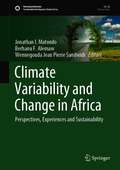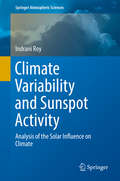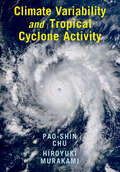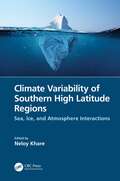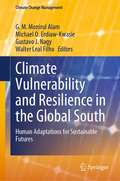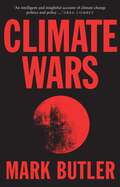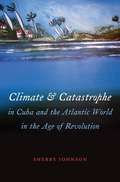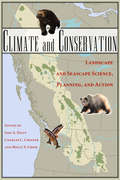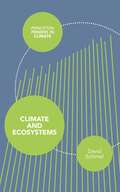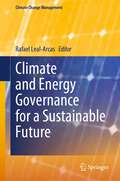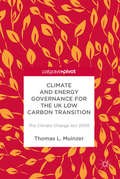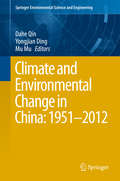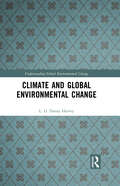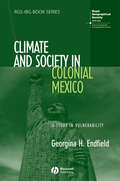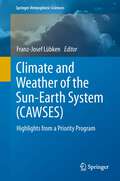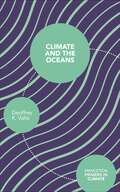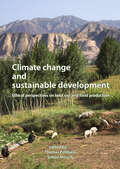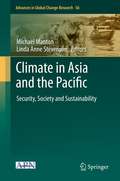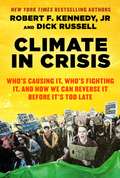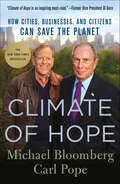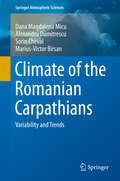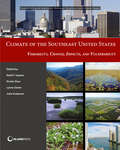- Table View
- List View
Climate Variability and Change in Africa: Perspectives, Experiences and Sustainability (Sustainable Development Goals Series)
by Jonathan I. Matondo Berhanu F. Alemaw Wennegouda Jean Pierre SandwidiThis book presents a comprehensive overview of climate variability and change in Africa, and includes impact assessments and case studies from integration frameworks, with a particular focus on climate, agriculture and water resources. Richly illustrated, the book highlights case studies from western, eastern and southern African region, and explores related development policies. Climate change adaptation research, prediction, and reanalysis are also addressed
Climate Variability and Sunspot Activity: Analysis of the Solar Influence on Climate (Springer Atmospheric Sciences)
by Indrani RoyThis book promotes a better understanding of the role of the sun on natural climate variability. It is a comprehensive reference book that appeals to an academic audience at the graduate, post-graduate and PhD level and can be used for lectures in climatology, environmental studies and geography. This work is the collection of lecture notes as well as synthesized analyses of published papers on the described subjects. It comprises 18 chapters and is divided into three parts: Part I discusses general circulation, climate variability, stratosphere-troposphere coupling and various teleconnections. Part II mainly explores the area of different solar influences on climate. It also discusses various oceanic features and describes ocean-atmosphere coupling. But, without prior knowledge of other important influences on the earth’s climate, the understanding of the actual role of the sun remains incomplete. Hence, Part III covers burning issues such as greenhouse gas warming, volcanic influences, ozone depletion in the stratosphere, Arctic and Antarctic sea ice, etc. At the end of the book, there are few questions and exercises for students. This book is based on the lecture series that was delivered at the University of Oulu, Finland as part of M.Sc./ PhD module.
Climate Variability and Tropical Cyclone Activity
by Pao-Shin Chu Hiroyuki MurakamiThis book presents a comprehensive summary of research on tropical cyclone variability at various time scales, from intraseasonal and interannual to interdecadal and centennial. It covers the fundamental theory, statistics and numerical modelling techniques used when considering climate variability in relation to tropical cyclone activity. Major climate oscillations including the Madden-Julian, El Niño, Atlantic Meridional Mode, and Pacific Decadal oscillations are covered, and their impacts on tropical cyclone activity in the Pacific and Atlantic oceans are discussed. Hurricane landfalls in the United States, Caribbean and East Asia are also considered. Climate models and numerical simulations are used to show how prediction models of tropical cyclones are developed, while looking to the future, particular attention is paid to predicting how tropical cyclones will change in response to increased concentrations of greenhouse gases. This book ideal for researchers and practitioners in atmospheric science, climatology, oceanography and civil and environmental engineering.
Climate Variability of Southern High Latitude Regions: Sea, Ice, and Atmosphere Interactions
by Neloy KhareThis is the first book to provide a comprehensive overview of climate change–related investigations carried out by Indian researchers through initiatives in southern high latitude regions. It explains climate variability over the Southern Ocean and Antarctica; air, sea, ice, and atmosphere interactions; and the impact of climate variability on sea ice and the polar atmosphere. The data were gathered at two Indian research bases, Maitri and Bharti, which are ideal sites to study and understand climatic evolution in Antarctic in the past and recent changes. This book helps to understand climatological perspectives and to evaluate some of the most pressing issues in the south polar region. FEATURES Highlights the achievements of India in the contemporary field of Antarctic climatology Presents four decades of research by Indian scientists in Antarctica, which is now shared for the first time with the global community Includes case studies on climatological and environmental conditions of natural archives to shed light on climate scenarios in the Southern Ocean and Antarctic regions Covers various aspects of climate variability and induced air-sea-ice-atmosphere interactions This book is edited by one of the top scientists and researchers of India in the field of paleoclimatology, and the contributors are experts in the Antarctic region.
Climate Vulnerability and Resilience in the Global South: Human Adaptations for Sustainable Futures (Climate Change Management)
by Walter Leal Filho Gustavo J. Nagy G. M. Monirul Alam Michael O. Erdiaw-KwasieThis book provides hands-on conceptual, theoretical, and case study discussions on vulnerability and resilience in the global south. This book covers the core of adaptation strategies in developing countries context in an easy-to-follow theoretical and empirical examples. This book shares contemporary approaches on vulnerability, adaptation strategies, and resilience, which aim to assist its targeted audience (academics, policymakers, and practitioners) to understand and make informed decisions in a wide variety of real-world resilience situations.
Climate Wars
by Mark ButlerAs the consequences of climate change become perilously close to the point of no-return, time-wasting wars over what to do distract us from taking real action.Mark Butler, the opposition minister for climate change and energy, makes a forceful case for using less and cleaner energy as part of global action to save the planet. Doing so will also make Australia attractive for the massive global market of investors and create new jobs in clean energy.Climate Wars argues that only Labor, the party with a proven track record for national reform, has the plan and the will to ensure bold action before it is too late.
Climate and Catastrophe in Cuba and the Atlantic World in the Age of Revolution
by Sherry JohnsonFrom 1750 to 1800, a critical period that saw the American Revolution, French Revolution, and Haitian Revolution, the Atlantic world experienced a series of environmental crises, including more frequent and severe hurricanes and extended drought. Drawing on historical climatology, environmental history, and Cuban and American colonial history, Sherry Johnson innovatively integrates the region's experience with extreme weather events and patterns into the history of the Spanish Caribbean and the Atlantic world.By superimposing this history of natural disasters over the conventional timeline of sociopolitical and economic events in Caribbean colonial history, Johnson presents an alternative analysis in which some of the signal events of the Age of Revolution are seen as consequences of ecological crisis and of the resulting measures for disaster relief. For example, Johnson finds that the general adoption in 1778 of free trade in the Americas was catalyzed by recognition of the harsh realities of food scarcity and the needs of local colonists reeling from a series of natural disasters. Weather-induced environmental crises and slow responses from imperial authorities, Johnson argues, played an inextricable and, until now, largely unacknowledged role in the rise of revolutionary sentiments in the eighteenth-century Caribbean.
Climate and Conservation: Landscape and Seascape Science, Planning, and Action
by Charles C. Chester Molly S. Cross Jodi A. HiltyClimate and Conservation presents case studies from around the world of projects focused on climate change adaptation-regional-scale endeavors where scientists, managers, and practitioners are working to protect biodiversity by protecting landscapes and seascapes in response to threats posed by climate change. The book begins with an introductory section that frames the issues and takes a systematic look at planning for climate change adaptation. The nineteen chapters that follow examine particular case studies in every part of the world, including landscapes and seascapes from equatorial, temperate, montane, polar, and marine and freshwater regions. Climate and Conservation offers readers tangible, place-based examples of projects designed to protect large landscapes as a means of conserving biodiversity in the face of the looming threat of global climate change.
Climate and Ecosystems (Princeton Primers in Climate #7)
by David SchimelHow does life on our planet respond to--and shape--climate? This question has never been more urgent than it is today, when humans are faced with the daunting task of guiding adaptation to an inexorably changing climate. This concise, accessible, and authoritative book provides an unmatched introduction to the most reliable current knowledge about the complex relationship between living things and climate. Using an Earth System framework, David Schimel describes how organisms, communities of organisms, and the planetary biosphere itself react to and influence environmental change. While much about the biosphere and its interactions with the rest of the Earth System remains a mystery, this book explains what is known about how physical and chemical climate affect organisms, how those physical changes influence how organisms function as individuals and in communities of organisms, and ultimately how climate-triggered ecosystem changes feed back to the physical and chemical parts of the Earth System. An essential introduction, Climate and Ecosystems shows how Earth's living systems profoundly shape the physical world.
Climate and Energy Governance for a Sustainable Future (Climate Change Management)
by Rafael Leal-ArcasThis book includes contributions by leading experts across the globe with the first part of the book focusing on the analysis of the Paris Agreement on Climate Change, examines COP26, and questions the political process in the US for the creation of policy for meaningful greenhouse gas emissions reductions. Part 2 explores various ways in which one can effectively mitigate climate change. The contents provide an analysis of carbon pricing, development of specific green energy technologies to promote economic prosperity, and analysis of electric vehicles and other elements of electrification in areas with carbon-intensive electricity supply. Part 3 analyses the international dimension of energy governance (both regional and global) and climate action. It further provides an analysis of the challenges faced by small island developing states, least-developed countries and other vulnerable places. It also offers an analysis of the prospects for a European Energy Union and explores why energy security and decarbonization are significant. Lastly, it explores global energy governance and how its fragmentation can be reduced. This volume will be a useful reference for those in industry and academia.
Climate and Energy Governance for the UK Low Carbon Transition: The Climate Change Act 2008
by Thomas L MuinzerThe UK Climate Change Act was the first case of a country implementing blanket legally binding long-term emissions reduction targets in order to combat climate change. This book provides the first accessible and in-depth analysis of the UK’s complex Climate Change Act framework, presenting the discussion in a clear and interdisciplinary manner designed to open the workings of the challenging framework to a broad audience. It discusses the political ‘story’ surrounding the framework, and its treatment in scholarly environmental literature; analyses the technical content of the Act; explores the framework’s international significance, and its internal ‘subnational’ dimensions and impact, engaging the UK’s devolved jurisdictions of Northern Ireland, Scotland, and Wales. This first, much-needed interdisciplinary treatment of the framework is both introductory and analytical in nature and will be of interest to scholars, practitioners and general readers of environmental studies, policy and governance.
Climate and Environmental Change in China: 1951-2012 (Springer Environmental Science and Engineering)
by Dahe Qin Yongjian Ding Mu MuThrough numerous color figures and tables, this book presents the most up-to-date knowledge on climate and environmental change in China. It documents the evidence and attribution of climate and environmental changes in the past few decades and discusses the impacts of climate change on environments, economy, and society. The book further provides projections of climate change and its impacts in the future. Finally, it offers the climate change mitigation and adaption technologies with strategic options which will be of interest for policy makers, researchers and the general public as well.
Climate and Global Environmental Change (Understanding Global Environmental Change)
by L. D. HarveyClimatic change, now more than ever in this age of global warming, is seen as fundamental to the study of the environment. This text examines the importance of climate as one of the major forcing functions in the global environmental change process. It emphasizes both human-induced climatic change and natural climatic change, providing a comprehensive historical context and important projections for the future. It offers a thorough, up-to-date, critical overview of the physical science behind global warming concerns.
Climate and Global Environmental Change (Understanding Global Environmental Change)
by L. D. HarveyClimatic change, now more than ever in this age of global warming, is seen as fundamental to the study of the environment. This text examines the importance of climate as one of the major forcing functions in the global environmental change process. It emphasizes both human-induced climatic change and natural climatic change, providing a comprehensive historical context and important projections for the future. It offers a thorough, up-to-date, critical overview of the physical science behind global warming concerns.
Climate and Human Migration
by Robert A. MclemanStudies warn that global warming and sea level rise will create hundreds of millions of environmental refugees. While climate change will undoubtedly affect future migration patterns and behavior, the potential outcomes are more complex than the environmental refugee scenario suggests. This book provides a comprehensive review of how physical and human processes interact to shape migration, using simple diagrams and models to guide the researcher, policy maker and advanced student through the climate-migration process. The book applies standard concepts and theories used in climate and migration scholarship to explain how events such as Hurricane Katrina, the Dust Bowl, African droughts, and floods in Bangladesh and China have triggered migrations that haven't always fit the environmental refugee storyline. Lessons from past migrations are used to predict how future migration patterns will unfold in the face of sea level rise, food insecurity, political instability, and to review options for policy makers.
Climate and Social Stress
by National Research Council Paul C. Stern Division of Behavioral and Social Sciences and Education Board on Environmental Change and Society John D. Steinbruner Jo L. Husbands Committee on Assessing the Impact of Climate Change on Social and Political StressesClimate change can reasonably be expected to increase the frequency and intensity of a variety of potentially disruptive environmental events--slowly at first, but then more quickly. It is prudent to expect to be surprised by the way in which these events may cascade, or have far-reaching effects. During the coming decade, certain climate-related events will produce consequences that exceed the capacity of the affected societies or global systems to manage; these may have global security implications. Although focused on events outside the United States, Climate and Social Stress: Implications for Security Analysis recommends a range of research and policy actions to create a whole-of-government approach to increasing understanding of complex and contingent connections between climate and security, and to inform choices about adapting to and reducing vulnerability to climate change.
Climate and Society in Colonial Mexico: A Study in Vulnerability (RGS-IBG Book Series)
by Georgina H. EndfieldBy considering three case study regions in Mexico during the Colonial era, Climate and Society in Colonial Mexico: A Study in Vulnerability examines the complex interrelationship between climate and society and its contemporary implications. Provides unique insights on climate and society by capitalizing on Mexico’s rich colonial archives Offers a unique approach by combining geographical and historic perspectives in order to comprehend contemporary concerns over climate change Considers three case study regions in Mexico with very different cultural, economic, and environmental characteristics
Climate and Weather of the Sun-Earth System: Highlights from a Priority Program (Springer Atmospheric Sciences)
by Franz-Josef LübkenCAWSES (Climate and Weather of the Sun-Earth System) is the most important scientific program of SCOSTEP (Scientific Committee on Solar-Terrestrial Physics). CAWSES has triggered a scientific priority program within the German Research Foundation for a period of 6 years. Approximately 30 scientific institutes and 120 scientists were involved in Germany with strong links to international partners. The priority program focuses on solar influence on climate, atmospheric coupling processes, and space climatology. This book summarizes the most important results from this program covering some important research topics from the Sun to climate. Solar related processes are studied including the evolution of solar radiation with relevance to climate. Results regarding the influence of the Sun on the terrestrial atmosphere from the troposphere to the thermosphere are presented including stratospheric ozone, mesospheric ice clouds, geomagnetic effects, and their relevance to climate. Several chapters highlight the importance of coupling mechanisms within the atmosphere, covering transport mechanisms of photochemically active species, dynamical processes such as gravity waves, tides, and planetary waves, and feedback mechanisms between the thermal and dynamical structure of the atmosphere. Special attention is paid to climate signals in the middle and upper atmosphere and their significance relative to natural variability.
Climate and the Oceans (Princeton Primers in Climate #5)
by Geoffrey K. VallisThe oceans exert a vital moderating influence on the Earth's climate system. They provide inertia to the global climate, essentially acting as the pacemaker of climate variability and change, and they provide heat to high latitudes, keeping them habitable. Climate and the Oceans offers a short, self-contained introduction to the subject. This illustrated primer begins by briefly describing the world's climate system and ocean circulation and goes on to explain the important ways that the oceans influence climate. Topics covered include the oceans' effects on the seasons, heat transport between equator and pole, climate variability, and global warming. The book also features a glossary of terms, suggestions for further reading, and easy-to-follow mathematical treatments. Climate and the Oceans is the first place to turn to get the essential facts about this crucial aspect of the Earth's climate system. Ideal for students and nonspecialists alike, this primer offers the most concise and up-to-date overview of the subject available. The best primer on the oceans and climate Succinct and self-contained Accessible to students and nonspecialists Serves as a bridge to more advanced material
Climate change and sustainable development: Ethical perspectives on land use and food production
by Thomas Potthast Simon MeischClimate change is a major framing condition for sustainable development of agriculture and food. Global food production is a major contributor to global greenhouse gas emissions and at the same time it is among the sectors worst affected by climate change. This book brings together a multidisciplinary group of authors exploring the ethical dimensions of climate change and food. Conceptual clarifications provide a necessary basis for putting sustainable development into practice. Adaptation and mitigation demand altering both agricultural and consumption practices. Intensive vs. extensive production is reassessed with regard to animal welfare, efficiency and environmental implications. Property rights pay an ever-increasing role, as do shifting land-use practices, agro-energy, biotechnology, food policy to green consumerism. And, last but not least, tools are suggested for teaching agricultural and food ethics. Notwithstanding the plurality of ethical analyses and their outcome, it becomes apparent that governance of agri-food is faced by new needs and new approaches of bringing in the value dimension much more explicitly. This book is intended to serve as a stimulating collection that will contribute to debate and reflection on the sustainable future of agriculture and food production in the face of global change.
Climate in Asia and the Pacific: Security, Society and Sustainability (Advances in Global Change Research #56)
by Michael Manton Linda Anne StevensonCommissioned by the Intergovernmental Meeting (IGM) of the Asia-Pacific Network for Global Change Research (APN), this book offers a detailed survey of the current status of climate change and climate variability in the Asia-Pacific region, a thorough and thoughtful assessment of climate and security and clear recommendations on the best paths of climate research in the future.
Climate in Crisis: Who's Causing It, Who's Fighting It, and How We Can Reverse It Before It's Too Late
by Dick Russell Robert F. Kennedy Jr.The science is overwhelming; the facts are in. The planet is heating up at an alarming rate and the results are everywhere to be seen. Yet, as time runs out, climate progress is blocked by the men who are profiting from the burning of the planet: Energy moguls like the Koch brothers and ExxonMobil CEO Rex Tillerson. Powerful politicians like Senators Mitch McConnell and Jim Inhofe, who receive massive contributions from the oil and coal industries. Most of these men are too intelligent to truly believe that climate change is not a growing crisis. And yet they have put their profits and careers ahead of the health and welfare of the world&’s population—and even their own children and grandchildren. How do they explain themselves to their offspring, to the next generations that must deal with the environmental havoc that these men have wreaked? With a new introduction from the authors, Climate in Crisis takes a very personal look at this global crisis, literally bringing it home.
Climate of Hope: How Cities, Businesses, and Citizens Can Save the Planet
by Michael Bloomberg Carl PopeNEW YORK TIMES BESTSELLERFrom Mayor Michael Bloomberg and former head of the Sierra Club Carl Pope comes a manifesto on how the benefits of taking action on climate change are concrete, immediate, and immense. They explore climate change solutions that will make the world healthier and more prosperous, aiming to begin a new type of conversation on the issue that will spur bolder action by cities, businesses, and citizens—and even, someday, by Washington."Climate of Hope is an inspiring must read." —Former Vice President Al Gore, Chairman of The Climate Reality Project“Climate change threatens to reshape the future of our world's population centers. Bloomberg and Pope have been leaders on fortifying our cities against this threat, and their book proves that victory is possible—and imperative.” —Leonardo DiCaprio"If Trump is looking for a blueprint, he could not do better than to read a smart new book, Climate of Hope." —Thomas Friedman in The New York Times~The 2016 election left many people who are concerned about the environment fearful that progress on climate change would come screeching to a halt. But not Michael Bloomberg and Carl Pope. Bloomberg, an entrepreneur and former mayor of New York City, and Pope, a lifelong environmental leader, approach climate change from different perspectives, yet they arrive at similar conclusions. Without agreeing on every point, they share a belief that cities, businesses, and citizens can lead—and win—the battle against climate change, no matter which way the political winds in Washington may shift. In Climate of Hope, Bloomberg and Pope offer an optimistic look at the challenge of climate change, the solutions they believe hold the greatest promise, and the practical steps that are necessary to achieve them. Writing from their own experiences, and sharing their own stories from government, business, and advocacy, Bloomberg and Pope provide a road map for tackling the most complicated challenge the world has ever faced. Along the way, they turn the usual way of thinking about climate change on its head: from top down to bottom up, from partisan to pragmatic, from costs to benefits, from tomorrow to today, and from fear to hope.
Climate of the Romanian Carpathians: Variability and Trends (Springer Atmospheric Sciences)
by Dana Magdalena Micu Alexandru Dumitrescu Sorin Cheval Marius-Victor BirsanThis book is a comprehensive climatic monograph, which addresses one of the most complex mountain environments in Europe, the Carpathians Chain, focusing on the branches that lie over Romania. The volume aggregates high quality input data, state-of-the-art techniques, regional analysis and overview perspectives, while addressing the spatial and temporal patterns of the main climatic elements. The study covers the period 1961-2010, for the present climate, while the perspective is extended up to 2050. The main climatic elements (e. g. air temperature, precipitation, wind) are analyzed, but some specific variables like snow depth and snow cover are also examined, both in terms of average behaviour and extreme characteristics. This is the first synthesis addressing the climate of this mountain region, and it provides useful information for scientists, mountain stakeholders, decision-makers and general public.
Climate of the Southeast United States: Variability, Change, Impacts, and Vulnerability (NCA Regional Input Reports)
by Kirstin Dow Julie Anderson Keith T. Ingram Lynne CarterPrepared for the 2013 National Climate Assessment and a landmark study in terms of its breadth and depth of coverage, Climate of the Southeast United States is the result of a collaboration among three Regional Integrated Sciences and Assessments Centers: the Southeast Climate Consortium; the Carolinas Regional Sciences and Assessments; and the Southern Climate Impacts Planning Program; with contributions from numerous local, state, federal, and nongovernmental agencies to develop a comprehensive, state of the art look at the effects of climate change in the region. The book summarizes the scientific literature with respect to climate impacts on the Southeast United States, including 11 southern states to the east of the Mississippi River, Puerto Rico, and the US Virgin Islands; reviews the historic climate, current climate, and the projected future climate of the region; and describes interactions with important sectors of the Southeast and cross-sectoral issues, namely climate change mitigation, adaptation, and education and outreach. Rich in science and case studies, it examines the latest climate change impacts, scenarios, vulnerabilities, and adaptive capacity and offers decision makers and stakeholders a substantial basis from which to make informed choices that will affect the well-being of the region's inhabitants in the decades to come.
